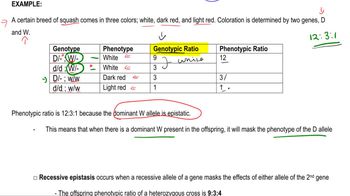In reptiles, sex determination was thought to be controlled by sex-chromosome systems or by temperature-dependent sex determination without an inherited component to sex. But in the Australian lizard, Pogona vitticeps, it was recently revealed that sex is determined by both chromosome composition and by the temperature at which eggs are incubated. What effects might climate change have on temperature-dependent sex determination in this species, and how might this impact the sex ratio for this species in subsequent generations?
Table of contents
- 1. Introduction to Genetics51m
- 2. Mendel's Laws of Inheritance3h 37m
- 3. Extensions to Mendelian Inheritance2h 41m
- 4. Genetic Mapping and Linkage2h 28m
- 5. Genetics of Bacteria and Viruses1h 21m
- 6. Chromosomal Variation1h 48m
- 7. DNA and Chromosome Structure56m
- 8. DNA Replication1h 10m
- 9. Mitosis and Meiosis1h 34m
- 10. Transcription1h 0m
- 11. Translation58m
- 12. Gene Regulation in Prokaryotes1h 19m
- 13. Gene Regulation in Eukaryotes44m
- 14. Genetic Control of Development44m
- 15. Genomes and Genomics1h 50m
- 16. Transposable Elements47m
- 17. Mutation, Repair, and Recombination1h 6m
- 18. Molecular Genetic Tools19m
- 19. Cancer Genetics29m
- 20. Quantitative Genetics1h 26m
- 21. Population Genetics50m
- 22. Evolutionary Genetics29m
2. Mendel's Laws of Inheritance
Sex-Linked Genes
Problem 29b
Textbook Question
In a cross in Drosophila involving the X-linked recessive eye mutation white and the autosomally linked recessive eye mutation sepia (resulting in a dark eye), predict the F₁ and F₂ results of crossing true-breeding parents of the following phenotypes: Note that white is epistatic to the expression of sepia.
sepia females x white males
 Verified step by step guidance
Verified step by step guidance1
Step 1: Understand the genetic basis of the problem. The white eye mutation is X-linked and recessive, meaning it is located on the X chromosome and only expressed in males (XY) or homozygous females (XX). The sepia eye mutation is autosomal and recessive, meaning it is located on a non-sex chromosome and expressed only in homozygous individuals (ss). Additionally, white is epistatic to sepia, meaning that if the white mutation is present, it will mask the expression of sepia.
Step 2: Determine the genotypes of the true-breeding parents. True-breeding sepia females will have the genotype ss (homozygous recessive for sepia) and will not carry the white mutation, so their X chromosomes will be wild type (X⁺X⁺). True-breeding white males will have the genotype XʷY (white mutation on the X chromosome) and will be homozygous wild type for sepia (SS).
Step 3: Perform the F₁ cross. The sepia female (X⁺X⁺, ss) will contribute one X chromosome (X⁺) and one s allele to each offspring. The white male (XʷY, SS) will contribute either the Xʷ or Y chromosome and one S allele to each offspring. Combine these contributions to determine the genotypes and phenotypes of the F₁ generation.
Step 4: Predict the F₁ phenotypes. All F₁ females will inherit X⁺ from the mother and Xʷ from the father, resulting in the genotype X⁺Xʷ. They will also inherit one s allele from the mother and one S allele from the father, resulting in Ss. Since X⁺ is dominant over Xʷ, the females will have wild-type eyes. All F₁ males will inherit X⁺ from the mother and Y from the father, resulting in the genotype X⁺Y. They will also inherit one s allele from the mother and one S allele from the father, resulting in Ss. Since X⁺ is dominant, the males will also have wild-type eyes.
Step 5: Perform the F₂ cross. Cross the F₁ individuals (X⁺Xʷ, Ss females with X⁺Y, Ss males). Use a Punnett square to determine the genotypes and phenotypes of the F₂ generation. Remember to account for the epistatic effect of the white mutation, which will mask the sepia phenotype in individuals with the Xʷ allele.
 Verified video answer for a similar problem:
Verified video answer for a similar problem:This video solution was recommended by our tutors as helpful for the problem above
Video duration:
2mPlay a video:
Was this helpful?
Key Concepts
Here are the essential concepts you must grasp in order to answer the question correctly.
X-linked Inheritance
X-linked inheritance refers to the pattern of inheritance for genes located on the X chromosome. In Drosophila, males have one X and one Y chromosome, while females have two X chromosomes. This means that X-linked recessive traits, like the white eye mutation, will manifest in males if they inherit the affected X, while females require two copies of the recessive allele to express the trait.
Recommended video:
Guided course

X-Inactivation
Epistasis
Epistasis is a genetic interaction where the expression of one gene is affected by one or more other genes. In this case, the white eye mutation is epistatic to the sepia mutation, meaning that the presence of the white allele will mask the expression of the sepia allele, regardless of its genotype. This concept is crucial for predicting phenotypic outcomes in genetic crosses.
Recommended video:
Guided course

Epistatic Genes
Punnett Square
A Punnett square is a diagram used to predict the genotypes and phenotypes of offspring from a genetic cross. By organizing the alleles of the parents, it allows for a visual representation of possible combinations in the F₁ and F₂ generations. This tool is essential for understanding inheritance patterns, especially when dealing with multiple alleles and epistatic interactions.
Recommended video:
Guided course

Chi Square Analysis
Related Videos
Related Practice
Textbook Question
922
views


